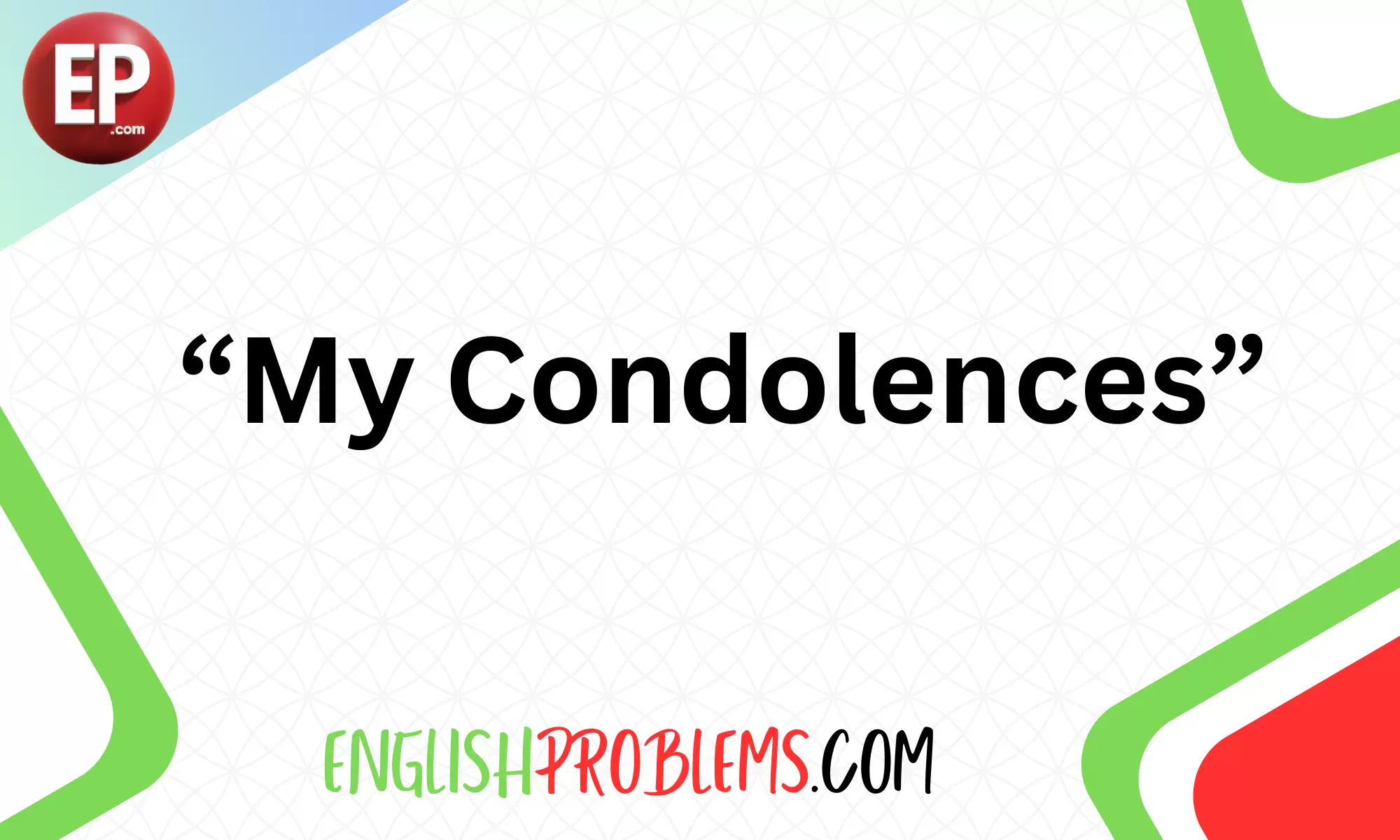Expressing sympathy during times of loss is a delicate matter. The phrases we use can offer comfort or, at times, may seem impersonal. One common phrase is “My condolences,” but is it always the best choice?
This article explores the term “condolences,” its evolution, and the nuances of using various sympathy expressions to ensure they are both appropriate and heartfelt.
Understanding the Term “Condolences”
The word “condolences” originates from the Latin word condolere, meaning “to suffer with.” It has been used for centuries to express sympathy and empathy toward those experiencing grief.
Historical Context
Traditionally, expressions of sympathy were formal and often included elaborate rituals or written messages. Over time, as communication evolved, the way we express condolences has adapted, yet the core sentiment of shared sorrow remains the same.
Modern Usage
Today, “condolences” is commonly used in both personal and professional contexts. However, its usage can sometimes come across as formulaic or detached. Understanding the historical background helps us appreciate the significance behind the words and guides us in choosing more personalized expressions.
Why “I’m Sorry for Your Loss” May Not Always Be the Best Choice
The phrase “I’m sorry for your loss” is widely used, but it might not always capture the depth of sympathy intended.
When It Falls Short
- Generic Nature: It can sometimes feel impersonal if not accompanied by a personal touch or specific acknowledgment of the deceased’s impact.
- Emotional Disconnect: For those deeply affected by the loss, generic phrases may seem inadequate or superficial.
Examples
- Less Suitable: “I’m sorry for your loss” in a casual workplace setting might not convey the needed empathy.
- Preferred Approach: For close friends or family, a more personalized message acknowledging the unique aspects of their relationship with the deceased can be more meaningful.
The Impersonal Nature of Common Condolence Phrases
Many common condolence phrases, while well-intentioned, can come across as impersonal.
Psychological Impact
- Impersonal Phrases: Phrases like “You have my condolences” or “Sorry for your loss” can sometimes feel like a formality rather than a genuine expression of sympathy.
- Personal Touch: A message that reflects personal memories or specific support can be more comforting.
Case Study
Consider the difference between:
- Impersonal: “I’m sorry for your loss.”
- Personal: “I remember how much your mother loved gardening. Her stories about her garden always made me smile. I’m so sorry for your loss.”
Crafting a More Personal and Supportive Message
A personalized condolence message can significantly impact the recipient. Here’s how to craft one:
Tips for Personalization
- Acknowledge the Individual: Mention something specific about the deceased or the relationship you shared with them.
- Offer Specific Support: Instead of a general offer of help, suggest concrete ways you can assist.
- Express Genuine Emotion: Share your feelings and memories to show empathy.
Examples
- Heartfelt Message: “I was deeply saddened to hear about your father’s passing. His kindness and wisdom were evident to everyone who knew him. If you need someone to talk to or help with anything, please don’t hesitate to reach out.”
Exploring the History and Evolution of Expressing Condolences
Understanding the evolution of condolence expressions can offer insights into their current use.
Historical Practices
- Traditional Methods: Historically, condolences were conveyed through formal letters, memorial services, or elaborate rituals.
- Modern Adaptations: Today, expressions of sympathy are often delivered through digital communication, which can lack the personal touch of traditional methods.
Cultural Variations
Different cultures have unique ways of expressing condolences, influenced by their customs and traditions. For example:
- Western Cultures: Often use phrases like “I’m sorry for your loss” or send sympathy cards.
- Eastern Cultures: May use specific rituals and ceremonies, such as burning incense or offering prayers.
When to Say “My Condolences” for Proper Etiquette
Using “My Condolences” appropriately involves considering the context and your relationship with the bereaved.
Guidelines for Use
- Formal Settings: Suitable for professional or formal situations where a respectful tone is required.
- Informal Settings: In more personal relationships, adding a personal touch to the message may be more appropriate.
Etiquette Considerations
- Timing: Offer condolences soon after the news is received to show timely support.
- Context: Ensure that the phrase fits the formality of the situation and your relationship with the recipient.
Navigating Formal and Informal Sympathy Expressions
Choosing the right expression of sympathy depends on the setting and your relationship with the bereaved.
Formal Expressions
- Examples: “Please accept my deepest sympathies” or “My thoughts are with you during this difficult time.”
- Context: Suitable for work colleagues, acquaintances, or formal interactions.
Informal Expressions
- Examples: “I’m so sorry to hear about your loss. If you need anything, I’m here for you” or “Your mother was an incredible person, and I’ll miss her too.”
- Context: More fitting for close friends or family where a personal touch is appreciated.
The Role of Relationship Depth in Choosing the Right Words
The depth of your relationship with the bereaved should influence your choice of words.
Close Relationships
- Personal Messages: Reflect on shared memories and the specific impact of the deceased on your life and the bereaved’s.
- Example: “I’ve always admired your father’s sense of humor. His stories brought so much joy to everyone who knew him.”
Acquaintances or Colleagues
- General Sympathy: Keep the message respectful and empathetic, without being overly familiar.
- Example: “I was saddened to hear about your loss. My thoughts are with you and your family.”
Alternative Ways to Express Sympathy and Shared Grief
While traditional phrases are common, exploring alternative expressions can offer a more personalized touch.
Alternative Expressions
- Heartfelt Notes: Write a personal letter or note sharing memories or expressing support.
- Acts of Kindness: Offer practical help, like cooking a meal or assisting with errands.
- Creative Gestures: Consider creating a memory book or photo album as a keepsake.
Examples
- Sympathy Gifts: Send a thoughtful gift that reflects the deceased’s interests or passions.
- Personal Gestures: Organize a small gathering to celebrate the life of the deceased.
Responding to Condolences: Acknowledging Sympathy with Gratitude
Acknowledging the support you receive is as important as expressing sympathy.
Effective Responses
- Express Gratitude: Thank the sender for their support and kind words.
- Acknowledge the Gesture: Mention how their message or action helped during your time of grief.
Examples
- Response to a Card: “Thank you for your kind words and for thinking of me during this difficult time. Your support means a lot to me.”
- Response to a Meal: “I appreciate the meal you brought over. It was a great comfort to have one less thing to worry about.”
Conclusion
Choosing the right words to express sympathy is a thoughtful process that goes beyond mere formality. While phrases like “My Condolences” are commonly used, personalizing your message can offer much-needed comfort and support. By understanding the term’s history, exploring different expressions, and acknowledging the support you receive, you can navigate the delicate task of offering sympathy with sincerity and empathy.
Remember, the essence of expressing condolences lies in showing genuine care and support, tailored to the recipient’s unique situation and your relationship with them.

Mia Evans brings a love for language and a knack for clarity to EnglishProblems.com. Her engaging writing style and expert knowledge help readers navigate the tricky terrain of English grammar with confidence and ease.










